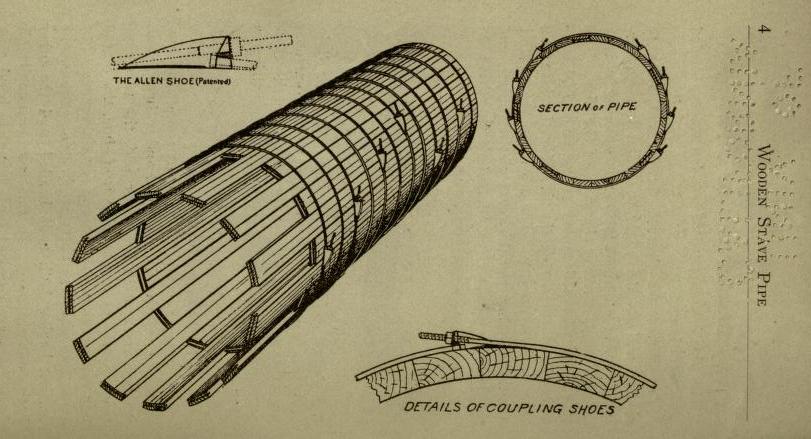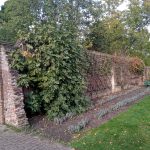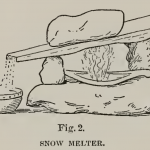“This book is intended to furnish general information regarding the construction, the advantages and the use of our wooden stave pipe”. “Wooden stave pipes“, Redwood Manufacturers Company, 1911. Via Arquitectura y Madera. Wooden pipes were (and occasionally still are) used for domestic water supply, irrigation, sewer systems and hydraulic power stations. Summary below the fold.
Durability
“When sound wood is kept thoroughly wet it does not rot. Hundreds of important stone structures depend for their stability and support on wooden piles ; and when the precaution was taken to use none but good material, and to keep it below low water level, no decay has resulted. These structures have stood the test of time, some of them for many centuries, and where parts have been removed, and old piles taken up, they have been found to be sound. Wooden bored water pipes of small diameter have been largely used in England and in some of our Eastern cities, and when dug up, after many years of continuous service, have been found as sound and clean as when they were put in.”
“The essential condition to insure an indefinite life of the wooden staves, is that they must be kept constantly saturated. This can best be attained by burying the pipe in the ground, as thereby all evaporation from the surface of the pipe will be prevented. If so buried, it is necessary that the pipe should run full at intervals of sufficiently long duration to cause and maintain complete saturation of the wood. When the staves are once thoroughly soaked they will remain so for an indefinite time if the pipe is buried and there be no ventilation through the pipe.”
“If it be admitted that the life of the staves, supposing the above condition to have been complied with, is indefinitely long, the life of the pipe as a whole is dependent upon that of the metal bands. In cast, wrought iron or steel pipe the metal serves the double purpose of forming the water-tight shell and providing the strength to resist water pressure. If the metal through corrosion fails in either purpose, the pipe has become useless. It is a notable fact that iron pipe never fails because of reduction in strength, but always because of a pitting action which affords numerous passages for the water, causing leaks.”
“This happens in riveted pipe long before corrosion has seriously weakened the strength of the metal, and such pipe would have a very much longer usefulness could its life be extended until the metal had actually become too weak to resist the strains from water pressure. Such increased life is secured to stave pipe because the metal is placed upon the pipe for purposes of strength only; and while steel pipe often has to be abandoned when but 5% of its strength is destroyed by corrosion, stave pipe would continue tight and the bands would not be strained beyond their elastic limit until 60% of the metal is rusted away.”
Construction
“In places along steep side hills and otherwise difficult of access, heavy hoisting apparatus or specially constructed roads can be avoided by the use of stave pipe. All the required material for the largest size pipe can be transported on the backs of mules, handled by at the most two men by hand or raised to the line of work by light cables or tramways. This is of great importance not only in first construction but in the matter of repairs should the work be damaged by land slides or from other exterior causes.”
“The absence of circumferential joints in its construction avoids serious local weakening of the strength of the pipe considered as a long tube, and this, taken in connection with its lightness and the possibility of producing tight work even with some water in the trench, has frequently led to its adoption in situations where, owing to the softness of the ground, other pipe would have required special foundation and expensive pumping operations.”
Carrying capacity
“The flow experiments on stave pipe that have so far been made may not entirely agree among themselves, any more than is the case with other classes of pipe, nevertheless it is an undisputed fact that the carrying capacity of stave pipe exceeds that of metal pipe, even under most favorable conditions. Entire absence of interior shoulders and smoothness of interior surface account for these results. While metal pipe is very liable to the formation of tubercles upon its interior surface, rapidly reducing its carrying capacity in the course of even a few years, stave pipe remains smooth and its carrying capacity unaffected by age.”
“It is well known that the carrying capacity of water pipe depends upon the smoothness of its interior surface. In this respect wooden pipe not only surpasses all other pressure pipe in the market, when it is new, but its capacity does not decrease with use, as is the case with wrought iron, steel and cast iron pipe. Our pipe will carry from ten to twenty per cent more water than iron or steel pipe when both are new and from thirty to fifty per cent more when both are ten years old.”
“Wooden flumes, which carry irrigation water on grade over rivers and depressions, are a familiar feature of irrigation canals. They have, however, some serious disadvantages, which render different methods of conveying the water very desirable. Exposed as they are to the action of the wind and sun, the wood warps and cracks, and since they are alternately wet and dry, the wood rots quickly. The trestles upon which they rest form an obstruction to the water in the creeks over which they cross, which, when coming down in freshets, endangers the entire structure. The pipe, when buried in the ground, is protected from the action of the atmosphere and leaves no obstruction to the flow of surface water over it.”
“Where water is developed from underground sources or where it is pumped to considerable height, it is of importance that great expense having been incurred in its collection, the water should all be saved and not be allowed to seep away in the ground before reaching its destination, to which clear water is particularly liable. Pipe lines instead of canals are for this reason best adapted to conduct water. They will also save whatever evaporation there may be from open ditches, will do away with troublesome growth of algae in this kind of water and with the annual expense of cleaning, and will admit of continued flow during the winter season for filling storage reservoirs.”
Sewers
“Sewerage has frequently to be conducted long distances to be discharged in the ocean, in natural streams or on sewer farms or filter beds. Where the pipe can be maintained full at intervals or where it lies in wet soil, or where sewage is pumped, conditions for the use of wooden pipe are favorable. In comparison with ordinary sewer pipe it has the advantage that it can be built tight even with a small amount of water in the trench, and that in soft and marshy soil no foundation is required, as the pipe when full is no heavier than the soil it displaces and has great longitudinal strength. Stave pipe has been so used in Los Angeles, Hollister, Palo Alto, Menlo Park and San Rafael, all in California; and the important fact that wood is in no way affected by the frequent acidulous character of the sewage is largely in its favor in comparing it with metal pressure pipes.”
Source: “Wooden stave pipes“, Redwood Manufacturers Company, 1911.






